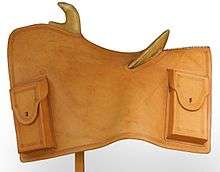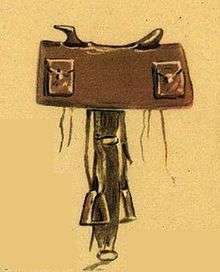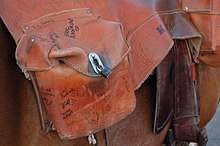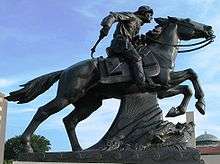Pony Express mochila
A mochila (Spanish,[1] pronounced [mo-chee-lah], for "knapsack", "pack", "pouch") is a removable lightweight leather cover put over a horse's saddle. In the 19th century, it was used as a mail bag by the Pony Express. Slits were cut through the eighth-inch leather to allow access to the saddle horn and cantle.[2]





Riders of the Pony Express made quick exchanges to new fresh horses, usually within a few minutes, at each remount station on their route across the United States. The mochila was removed from the exhausted horse and swiftly placed over the saddle of the fresh waiting horse.[3]
Etymology
Linguist Joan Corominas derived the Spanish mochila from mochil ("delivery boy"), itself from Basque mutil ("boy").[4] The word "mochila" connotes the soft sheepskin leather.
History and usage
Saddle bag mail pouches were never in use on the Pony Express system because of their unwieldiness. The normal large saddle bags could not be attached to a saddle efficiently and would cause much delay when switching from an exhausted horse to a fresh horse at a Pony Express station.[5] In 1860, the Pony Express developed a fast mail delivery system using a special saddle mail bag cover called a mochila that made the Pony Express unique. The cover, which had four hard leather boxes to carry the mail, was transferred quickly and efficiently, usually in less than two minutes. If a horse was injured on the way from one station to another and not capable of further traveling, a rider would simply remove the cover with its mail from the injured horse and walk to the next station, where he would throw the cover on a new horse. The leather blanket cover was designed by Pony Express rider Jay G. Kelley.[2][6][7][8]
The mochila also had four pockets, called cantinas, that were lockable with a type of small padlock and could only be unlocked by authorized people. Two cantinas were in front of the rider's legs and two were behind the rider's thighs. Documents to be transported in the cantinas would first be covered with oiled silk to protect them from water and sweat.[6] This mail service was very expensive (between one and five dollars per half-ounce, an astronomical amount that only businesses could afford).[3]
Most Pony Express saddles and mochilas were made by Israel Landis' shop in St. Joseph, Missouri.[9] Israel made the entire saddle about one-third the weight of the ordinary Western saddle.[5] The specially designed saddle with its mochila weighed less than 13 pounds.[5] The saddles and mochilas were standardized so they would work from one horse to another. When full of mail and telegrams, the mochila weighed about 20 pounds.[2] The rider would also carry a canteen of water, a gun and a small Bible that included the solemn Pony Express loyalty oath.[10][11]. The saddles for the horses that traveled over the Overland Pony Express route were special and standardized, built by a saddlery firm owned and franchised by Landis.
No authentic Pony Express mochilas have survived. Replicas have been made for demonstrations such as Wild West performances and modern-day reenactments.[12]
Bibliography
References
- mochila, Diccionario de la Real Academia Española, 22ª edición.
- Tucker, p. 18
- Pope, Nancy. "Pony Express Mochila". Former Object of the Month. National Postal Museum, Smithsonian Institution. Retrieved August 17, 2012.
- mochila in Diccionario crítico etimológico de la lengua castellana, volume III, page 392, Joan Corominas, Francke Verlag-Bern, 1954 ISBN 84-249-0066-9
- "The Mochila". Pony Express History. Retrieved August 16, 2012.
- Van der Linde, p. 23
- Israel Landis
- Pony Express saddle
- Ridge, Martin (Autumn 1996). "Reflections on the Pony Express". Montana: The Magazine of Western History. Montana Historical Society. 46 (3): 2–13.
- KidCaps 2012, p. 21.
- Marlow 2013, p. 94.
- "The Horse". Canadian Museum of Civilization. May 28, 2010. Retrieved August 17, 2012.
Sources
- KidCaps (2012). The Pony Express: A History Just for Kids!. BookCaps Study Guides. ISBN 978-1-62107-450-2.CS1 maint: ref=harv (link)
- Van der Linde, Laurel (1993). The Pony Express. New York: New Discovery Books. ISBN 0027590569.
- Marlow, Susan (2013). Canyon of Danger. Kregel Publications. ISBN 978-0-8254-7980-9.CS1 maint: ref=harv (link)
- Tucker, Mary (2012). Pony Express (ebook). Lorenz Educational Press. ISBN 0787786063.
Further reading
- Cushing, Marshall (1893). The Story of Our Post Office: The Greatest Government Department in all its Phases. Boston, Massachusetts: A. M. Thayer & Co – via Internet Archive.
- Melius, Louis (1917). The American postal service: history of the postal service from the earliest times. The American system described with full details of operation. Washington, D.C.: National Capital Press. Retrieved August 15, 2012 – via Internet Archive.
External links
| Look up mochila in Wiktionary, the free dictionary. |
| Wikimedia Commons has media related to mail bags. |